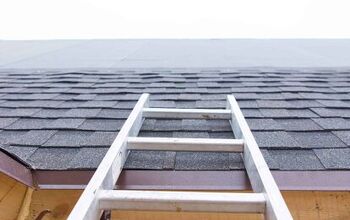How To Put Plastic On Windows Outside (Step-by-Step Guide)

If you live in a climate with a harsh winter season, you may want to winterize your windows. This can help keep cold air from penetrating the windows and creating drafts in the house. This can be achieved by covering the exterior of your windows with plastic.
To put plastic on the exterior of your windows, select a proper thickness of plastic sheeting. Then, measure the windows and cut the sheeting to fit. Fasten the plastic with double-sided tape, enclosing the window frame. Seal it with clear, all-weather tape.
In this article, we will cover each of the steps to get the best insulation from your window plastic. By making sure that you have an airtight seal, you could prevent needlessly high heating bills. Following the below steps will ensure a weatherproofing that will last all season.
Does Covering Windows With Plastic Really Help?
Even though they are expensive, double pane windows can have minuscule cracks in the seals. Cold air has a way of sneaking in the house anyway it possibly can. This is preventable with an airtight, weatherproof plastic covering.
Putting plastic up over your windows can help reduce up to 55% of heat leakage from your home. This can be a massive money saver in the winter, especially with heat retention being so important. Holding on to more of the heat you’re paying for is crucial.
One way to tell if plastic sheeting will help is to do the paper test. To do this test, place a piece of paper in between the window and the window sill. If you can move the paper back and forth after closing the window, plastic sheeting will help.
Interior Vs. Exterior Weather Proofing
There is a great deal of debate about whether or not windows should be covered with plastic inside or outside. As with so many things in home improvement, the answer is: it depends. Knowing your needs will definitely help you decide.
Covering the interior of your windows could possibly be a good permanent solution. For this, you can actually heat shrink the plastic to form a perfect seal. However, this will be difficult to remove when the weather changes and will have to be done all over again the next winter.
The reason many people do not want to weatherproof the exterior of their windows is that it can get damaged. However, it is much easier to install the plastic sheeting on the outside. If you consider this to be a temporary installation for the season, damage should be no problem
Step 1: Select Sheeting
The first thing you are going to want to do is select the kind of plastic sheeting you are going to use. You want something that is thin enough to be stretched, but thick enough to hold back cool air. Because of this, something as thin as plastic wrap will not be sufficient.
If you like, there are kits for weatherproofing your exterior windows. These come with pre-taped sheets that can be fitted directly over the window frames. However, the downside of these is that they are not cut to your specifications, so it will be harder to get a tight seal.
There are a few different types of plastic sheeting you can use for this project. However, the best kind of plastic to use is flexible vinyl sheeting. Vinyl is extremely water-resistant and durable in inclimate weather, making it perfect for this job.
Step 2: Measure the Windows
When measuring, it is best to be methodical and understand that you will need a little bit of extra room. Leaving one to two inches extra space around the edges will give you room for a tight seal. Making sure there are no gaps is crucial to effective weatherproofing.
When measuring the height, measure from the top of the sill to the top of the window opening itself. Take three measurements for each dimension of the window. Measure on side, the middle, then the other side.
When measuring the width, measure between the window jambs themselves. This should encompass the entire frame and not just the glass. Do the same three-point measuring that you did for the height.
Step 3: Cut and Fasten the Sheets
Cutting your sheets is the most important step to getting a tight seal. Too much excess plastic will be difficult to stick down and will not properly seal. This will allow cold air to enter the house and negate all your work.
To cut the sheets, mark them off, making sure to add the extra one to two inches. Then, on a cutting surface, use a utility knife to cleanly slice along your marks. Make sure that whatever you are cutting on is protected if you don’t want to scratch it up.
Set aside the sheets as you cut. If you have purchased one of the pre-taped and pre-cut kits, check to make sure that they will be large enough. To ensure this, measure your windows before purchasing the kit.
Attach double-sided tape around the edges of the sills and jambs. Using this, hang the sheets and place them where they are even and offer the most coverage. Repeat this process for all the windows until you are happy with the coverage.
Step 4: Seal the Edges
Finally, with clear, all-weather tape, go around to each window and seal the edges. Make sure that you have completely covered any openings or cracks in the sheeting. Go around to each window and double seal them with the all-weather tape.
If you have checked everything to make sure that the plastic is completely sealed, these should last all winter. They will have to be taken down in the summertime as they will usually not last more than one season. However, for the relatively low price, it is worth doing every year.
Other Weatherproofing Ideas
It is possible to shrink wrap the interior of your windows as well. This will only serve to keep the heat in even more and make the windows that much more energy efficient. However, you do not want to keep your windows double-sealed year-round.
It is also a good idea to go around your yard and look at what else should be weatherproofed. Things like faucets, birdbaths, and more all need to be taken into consideration for the winter. Covering faucets and bringing in any delicate yard ornaments is recommended.
Related Questions
Is aluminum foil a good insulator?
Aluminum foil could be a good choice for insulating the interior of your windows. It is a fairly good insulator and can do a good job of keeping heat out in the summer as well. However, it also blocks the windows and may not be the best option if you like lots of natural sunlight.
How do I winterize my front door?
You can winterize your front door using weather stripping. Weatherstripping is adhesive-backed rubber that can be run along the door jamb and edge of the door. You can also install a door sweep which will cover up any gaps at the bottom of the door.
How can I heat my home cheaply?
One of the most efficient ways to heat your home is by getting a pellet stove. Pellet stoves are relatively inexpensive to install and very inexpensive to run. They can also be installed with your existing fireplace.

I am a writer and editor from The Bay Area, CA. When I'm not typing, I enjoy hiking, woodworking and gardening. I love sharing tips and discovering new trends in home improvement.
More by Michael Oconnor



























